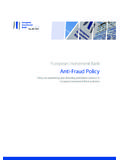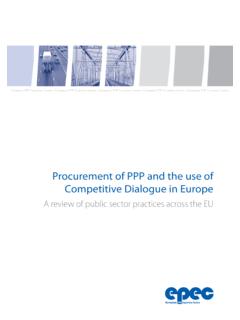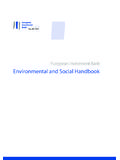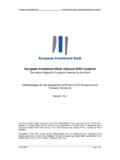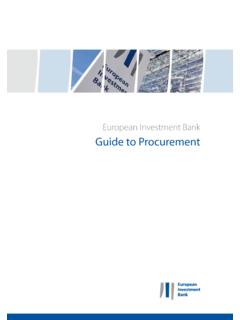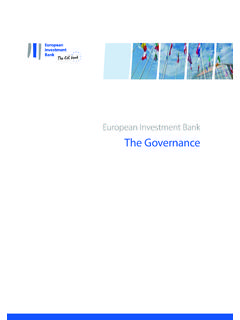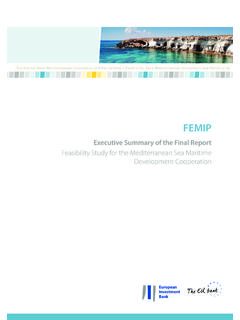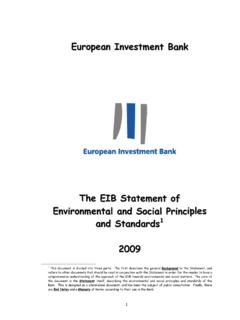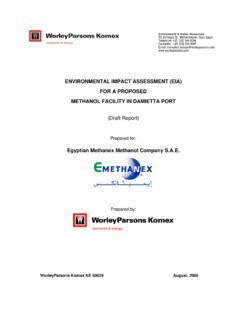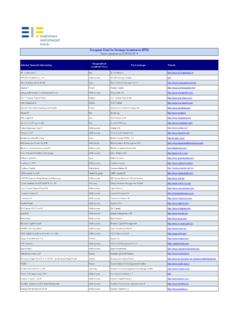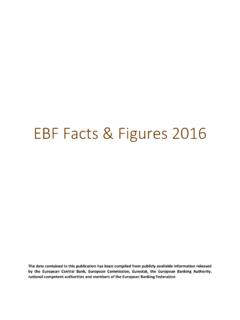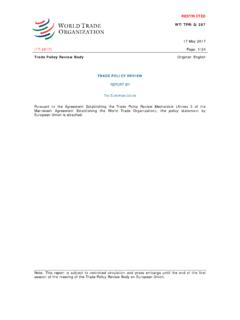Transcription of Operational Plan 2015-2017 - European Investment …
1 European Investment Bank Group Operational plan 2015 - 2017 . THE EIB GROUP. Operational plan . 2015 - 2017 . Important notices: The Operational plan 2015 - 2017 was discussed and approved by the Board of Directors of the European Investment Bank at its meeting of 21 April 2015 . Attention is drawn to the fact that this document contains forward-looking statements such as projections of financial performance. Such statements and projections may, by their nature, prove to be inaccurate. Data that are confidential and/or financially sensitive in nature have been removed from this publication. Foreword Luxembourg, 21 April 2015 . The Bank's responsiveness to the economic environment and its role as the EU bank has been repeatedly proven and is a commitment which is strongly retained. In late 2008, as the financial and economic crisis began to unfold, the EIB quickly adapted its business approach to drive extraordinary levels of business activity in an effort to alleviate market difficulties in accessing credit.
2 The Bank continued to implement EU. policy lending, supporting sound investments and actively grew lending volumes through the early years of the crisis. Faced with significant challenges in balancing the requirement for higher risk operations with the need for financial self-sufficiency, the Bank welcomed the 2012 announcement of a capital increase to be paid by the EU Member States in early 2013. To accelerate market Investment , the EIB stepped up lending volumes in 2012 in anticipation of the capital increase. The capital increase was galvanised in the Growth & Employment Facility (GEF) - foreseen to last through to end 2015 , increasing volumes by EUR 20bn compared to 2012 levels. Again to accelerate market investments, the Bank exceeded the associated stretch targets in 2013 and 2014. In mid-2014, a Commission-EIB partnership was announced, forming part of the Investment plan for Europe, in which EIB would play a major role.
3 This final Operational plan 2015 - 2017 was approved in April 2015 and elaborates on how the EIB will optimise the capital resources currently available to deliver on, and indeed to exceed, the commitments made to the European Council and Member States following the capital increase as well as the Bank's anticipated contribution to the Investment plan for Europe which is expected to be supported by an additional guarantee from the EU budget. Overall annual signatures targets for 2015 - 2017 . remain high at EUR 71bn An essential part of the partnership put forward by the Commission is to set up a new European Fund for Strategic Investments ( efsi '). This should be a distinct facility for assets generated by the EIB and backed by the EU budget. The structure and expected input and outputs for the currently foreseen period 2015 -2018 are illustrated below: The establishment of efsi has a number of fundamental legislative stages.
4 Progress is being made on defining and setting the legal base and the governance structure which has to take into account the need to optimise time to implementation. The decisions on the EIB's implementation of efsi and the approval of the underlying operations will be taken by EIB Governing Bodies with the relevant efsi bodies considering the applicability of the EU Guarantee to such underlying operations. Measures will be required for activity prioritisation and identification of Investment opportunities. The amounts involved in efsi are highly significant - being built on a guarantee of EUR. 16bn from the EU budget, combined with EUR 5bn contributed from the own resources of EIB. Such resources will back new lending by the EIB Group and unlock investments in the real economy of more than EUR 315bn over and above what the Bank would have otherwise been able to provide. The efsi products would comprise for example, debt financing (subordinated or senior), guarantees, equity, quasi-equity and venture capital.
5 Such risk-sharing Special Activities under efsi would significantly increase EIB's higher risk lending. Pending finalisation of the legal basis for efsi and thus even before the EU budget contribution is formally approved, in 2015 the EIB will use existing capital to warehouse' operations which may ultimately qualify for the associated EU Guarantee. 2015 will be a transition year leading into 2016 and 2017 as the core efsi Investment years. In 2016 and 2017 , the targets foreseen under existing risk-sharing instruments and higher risk activities, together with the efsi could push the level of overall signatures which are foreseen to be Special Activities to as much as 30% of total signatures. Given that in recent years, Special Activities per se have formed a ~6% of overall signatures, an unprecedented challenge exists which requires a quantum change in the Bank's business profile. In addition to the efsi , a new European Investment Advisory Hub will also be created as a contribution to the Investment plan for Europe.
6 Building on the experience gained from past initiatives, it will constitute a single point of entry for project promoters, investors and public managing authorities with the aim to improve project preparation and implementation and to help to share experience and expertise that can enhance access to finance and ensure more optimal use of available EU funds. The delivery model will thus be adapted to the different products, the specific efsi Investment potential and national capacity to develop viable investments in different sectors. During the implementation of efsi and the Advisory Hub, close attention will be paid to transparency with appropriate attention to responsibilities and accountabilities in line with best banking practices and EU budget administrative requirements. THE EIB GROUP. Operational plan 2015 - 2017 . Table of Contents 1. The EU bank Investing to restore EU competitiveness.
7 1. 2. Economic environment .. 4. 3. EU institutional environment .. 6. 4. Lending and Borrowing (Funding) Programme .. 7. 5. Co-operation with the Commission and other third 16. 6. Risk Management, Financial and Budgetary Planning .. 20. 7. Performance Indicators .. 22. 8. Decisions of the Board of Directors .. 24. Annex 1: Operational Activity .. 25. Annex 2: Activities in support of Public Policy Goals .. 29. Glossary of Terms .. 33. European Investment Bank Operational plan 2015 - 2017 . 1. The EU bank Investing to restore EU competitiveness The economic recovery remains fragile, and the crisis has led to a significant reduction in both the EU competitiveness vis- -vis other leading economies and in the estimated EU. longer-term growth potential. Despite recent expansive monetary policy and liquidity support, Investment levels are still weak. The EU is struggling with a large Investment shortfall as public and private sector deleveraging has impacted capital stock.
8 The EU. employment crisis shows modest signs of recovery in some countries, but will continue to generate socio-economic challenges over the short and long-term. Supported by structural reforms, Investment growth is needed to drive recovery, sustain employment, curb the long-term decline in EU competitiveness and address shortfalls in human capital and physical infrastructure and in impaired/under-developed financial sectors. Significant infrastructure Investment backlogs are seen in the energy, transport, telecommunications and environmental services sectors which are undermining competitiveness. At the same time, many of these Investment gaps are currently far from being Investment projects ready to be financed. Europe 2020 still remains the EU's main over-arching growth strategy. After four years of implementation, a mid-term review of the Europe 2020 strategy has been initiated. Building on preliminary lessons learned during the first years - and in a context of a gradual recovery of European economies - the purpose is to reflect on the design of a post-crisis growth strategy for the coming years.
9 The review is intended to inform the creation of an environment conducive to Investment and a plan for kick-starting Investment by catalysing private investments through public initiative will be the main objective of the new Commission. Also included is the new Investment plan for Europe. The Bank's status as the EU bank' was underlined with the EUR 10bn capital increase approved in 2012. This capital increase was to enable additional financing of viable Investment projects in the range of EUR 180bn between 2013- 2015 , across all Member States of the EU, and especially those projects aimed at sustainable long-term growth and employment in the EU. The EIB has delivered on this target ahead of schedule, and commits to continue its important catalytic role to resolve the current Investment and competitiveness challenges in the EU. The EIB's contribution will be most efficient if it maintains a lending programme which includes a substantial level of higher-risk taking components in its product mix, given that the risk bearing capacity of the financial sector is often the binding constraint to be overcome to unlock economically sound investments.
10 Furthermore, lending under the proposed efsi will enable Investment projects which would otherwise encounter financial barriers and would hence not receive financing on appropriate terms. With its wide range of specialist risk finance products, EIF continues to complement EIB's business as the EU. bank' in fostering growth, jobs and innovation in Europe. This role will be further strengthened with the extension of EIF's current activities by way of participation to the Investment plan for Europe. However, the Bank must still respect its own available resources and risk bearing capacity, so as not to endanger its creditworthiness. Also, it is necessary to acknowledge that the activities of the EIB face additional challenges related to ample liquidity provision by central banks, tightening regulation for financial institutions and lack of demand requiring the Bank to continuously adapt and innovate its product range.
